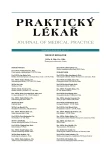A use of epidemiology data for cancer risk assessment and the precautionary principle
Authors:
V. Bencko; I. Holcátová; M. Schejbalová; A. Slámová
Authors‘ workplace:
Přednosta: doc. MUDr. Milan Tuček, CSc.
; Ústav hygieny a epidemiologie 1. lékařské fakulty UK a VFN v Praze
Published in:
Prakt. Lék. 2012; 92(2): 92-95
Category:
Of different specialties
Overview
The traditional approaches and study designs in cancer epidemiology have not been very successful in identifying and evaluating adequately the potential risk and/or protective factors associated with the disease. The main reasons for the failure are often due to small study sample size, and inadequate exposure information.
In this paper, issues and approaches relevant to these two challenges are discussed.
A multicentre study is proposed as a way to increase study size and to mitigate criticism about meta-analysis of independent studies.
A multicentre study of a large cohort or case–control studies also offers an exciting opportunity to study the contribution of epigenetic events that may be associated with life-style and environment risk factors for human health. Optimizing methods for exposure assessment and how to reduce exposure misclassification represent a difficult component in epidemiology studies. A potentially useful approach for improving exposure estimates is to rely on biomarkers of exposures. An example is provided to demonstrate how biomarkers of exposures could provide valuable information in addition to exposure measurements in traditional epidemiological studies.
Finally, it is argued that risk assessment and the precautionary principle should not be viewed as conflicting paradigms but, rather, as a complementary approaches for developing appropriate policies to address risks posed by exposure to carcinogens and a wide spectrum of other health hazards.
Key words:
epidemiological data, risk assessment, precautionary principle, cancer epidemiology, carcinogenicity, multicentre studies, genomics of cancer, epigenomics.
Sources
1. Bencko, V. Možnosti a omezení použití epidemiologických dat při hodnocení rizika karcinogenity. Hygiena 2012, 57(1), v tisku.
2. Stayner, L.T., Boffetta, P., Vainio, H. Risk assessment of carcinogenic hazards. In: Schottenfeld D, Fraumeni JF, Jr. (Eds.) Cancer epidemiology and prevention, 3rd ed. Oxford: Oxford University Press, 2006: p. 65-69.
3. Brennan, P., Hsu, C., Moullan, N. et al. Effect of cruciferous vegetables on lung cancer in patients stratified by genetic status: a mendelian randomization approach. Lancet 2005, 366(4), p. 1558-1560.
4. Moore, L., Brennan, P., Karami, S. et al. Glutathione S-transferase polymorphisms, cruciferous vegetable intake and cancer risk in the Central and Eastern European Kidney Cancer Study. Carcinogenesis 2007, 28(9), p. 1960-1964.
5. Thompson, S., Pocock, S. Can meta-analysis be trusted? Lancet 1991, 338: p. 1127-1130.
6. Blettner, M., Sauerbrei, W., Schlehofer, B. et al. Traditional reviews, meta-analyses and pooled analyses in epidemiology. Int. J. Epidemiol. 1999, 28(1): p. 1-9.
7. Stroup, D., Berlin, J., Morton, S. et al. Meta-analysis of observational studies in epidemiology: A proposal for reporting. JAMA 2000, 283(15), p. 2008-2012.
8. Benke, G., Sim, M., Forbes, F., Salzberg, M. Retrospective assessment of occupational exposure to chemicals in community-based studies: validity and repeatability of industrial hygiene panel ratings. Int. J. Epidemiol. 1997, 26(3), p. 635-642.
9. Herceg, Z. Epigenetics and cancer: towards an evaluation of the impact of environmental and dietary factors. Mutagenesis 2007, 22(2), p. 91-103.
10. Riboli, E., Kaaks, R. The EPIC Project: rationale and study design. European prospective investigation into cancer and nutrition. Int. J. Epidemiol. 1997, 26 (Suppl. 1) S6–S14.
11. Hung, R.J., van der Hel, O., Tavtigian, S.V. et al. Perspectives on the molecular epidemiology of aerodigestive tract cancers. Mutat. Res. 2005, 592, p. 102-118.
12. Scelo, G., Constantinescu, V., Csiki, I. et al. Occupational exposure to vinyl chloride, acrylonitrile and styrene and lung cancer risk (Europe). Cancer Causes Control 2004, 15, p. 445-452.
13. Chen, C., Gibb, H. Procedures for calculating cessation lag. Regul. Toxicol. Pharmacol. 2003, 38, p. 157-165.
14. Chen, C. Lingering Effect: Epidemiological information useful for risk assessment. Regul. Toxicol. Pharmacol. 2008, 52, p. 242-247.
15. Bencko, V. Risk assessment and human exposure to endocrine disrupters. In: Jedrychowski WA, Perera FP, Maugeri U. (Eds.) Molecular epidemiology in preventive medicine. Luxemburg: International center for studies and research in biomedicine 2003, p. 315-327.
16. Bencko, V., Rameš, J., Ondrušová, M. et al. Human exposure to polyhalogenated hydrocarbons and incidence of selected malignancies - Central European experience. Neoplasma 2009, 56(4), p. 359-356.
17. Silbergeld, E.K. Risk assessment: the perspective and experience of U.S. environmentalists. Environ. Health Perspect. 1993, 101, p. 100-104.
18. Stayner, L. Protecting public health in the face of uncertain risks: the example of diesel exhaust. Am. J. Public. Health. 1999, 89, p. 991-993.
19. Commission of the European Communities. Communiqué on the precautionary principle. Brussels: European Commission 2000.
20. Kriebel, D., Tickner, J. Reenergizing public health through precaution. Am. J. Public Health 2001, 91, p. 1351-1361.
21. Bencko, V. Use of epidemiological data for cancer risk assessment: Approaches, concepts, and issues. Open Epidemiol. J. 2010, 3, p. 147-151.
22. Bencko, V. Primární prevence nemocí: současná úskalí a šance. Prakt. Lék. 2011, 91(3), s. 127-130.
Labels
General practitioner for children and adolescents General practitioner for adultsArticle was published in
General Practitioner

2012 Issue 2
- Advances in the Treatment of Myasthenia Gravis on the Horizon
- What Effect Can Be Expected from Limosilactobacillus reuteri in Mucositis and Peri-Implantitis?
- Metamizole in perioperative treatment in children under 14 years – results of a questionnaire survey from practice
- Memantine Eases Daily Life for Patients and Caregivers
- Metamizole vs. Tramadol in Postoperative Analgesia
Most read in this issue
- Gluten enteropathy
- Subliminal perception, medicine and addictive diseases
- Primary prevention in general practitioner surgeries
- Electronic documentation for nursing diagnostics in home care
